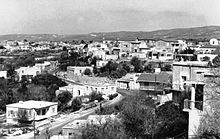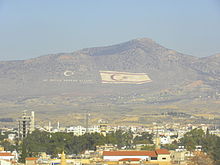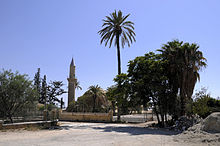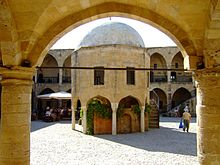- Turkish Cypriots
-
Turkish Cypriots
Kıbrıslı Türkler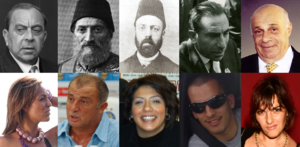
1st row: Fazıl Küçük · Kıbrıslı Mehmed Kamil Pasha · Kaytazzade Mehmet Nazım · Alparslan Türkeş · Rauf Denktaş
2nd row: Ziynet Sali · Fatih Terim · Işın Karaca · Leon Osman · Tracey EminTotal population est. 800,000-1,100,000 (see also Turkish Cypriot diaspora)
Regions with significant populations  Northern Cyprus
Northern Cyprus150,000-200,000 a [1][2]  Turkey
Turkey300,000-500,000 [3][4][5][6]  United Kingdom
United Kingdom300,000-400,000 [7][8][9][10]  Australia
Australia40,000-60,000 [6][9][11][12]  United States
United States5,000-10,000 [13]  Canada
Canada2,000 [9]  Cyprus
Cyprus2,000 [14] Languages Religion Predominantly Islam
Footnotes a This figure does not include Turkish settlers from Turkey. Turkish Cypriots (Turkish: Kıbrıs Türkleri or Kıbrıslı Türkler Greek: Τουρκοκύπριοι) are the ethnic Turks and members of the Turkish-speaking ethnolinguistic community of the Eastern Mediterranean island of Cyprus. The term is used to refer explicitly to the indigenous Turkish Cypriots, whose Ottoman Turkish forbears colonised the island in 1571. About 30,000 Turkish soldiers were given land once they settled in Cyprus,[15][16] which bequeathed a significant Turkish community; today's Turkish Cypriots.[17]
Contents
History
Ottoman troops landed in Cyprus in mid-May 1570 and conquered it within a year from Venetian rule.[18] The Turkish arrival to the island was welcomed by the Greek Cypriots as it was an improvement on Catholic domination and on the principle that anybody was better than the Venetians.[18][19][20] After the defeat of the Venetians in 1571, the Turkish commander, Lala Mustafa Paşa, chose 12,000 infantry and 4,000 cavalrymen to stay behind as colonists.[21] Furthermore, a substantial number of Turkish soldiers and their families from the Mediterranean region of Turkey, approximately 20,000, went to Cyprus and were given fiefs on the island. A fief was a parcel of real estate given by Sultan Selim II to his soldiers in return for their service to him.[16] By the late sixteenth century there was an estimated 40,000-60,000 Turks in Cyprus.[22]
Throughout the Ottoman rule, the demographic ratio between Christian "Greeks" and Muslim "Turks" fluctuated constantly.[23] By 1777-1788 the Turkish Muslim (and some Greek Muslim) population constituted the majority on the island, with 40,000 Muslim Turks and 37,000 Christian Greeks.[24] In 1788-1792 Turks were estimated at 45,000 compared to 40,000 Greeks.[24] However, by 1841, Turks made up 27% of the island's population.[25] The reason for this decline is because the Turkish community were obliged to serve in the Ottoman army for years, usually away from home, very often losing their lives in the endless wars of the Ottoman Empire.[26]
By 1878, during the Congress of Berlin, Cyprus was 'rented' to the British with the condition that Britain would come to the Ottoman Empire's aid in case of a Russian attack. However, in 1914, the Ottoman Empire established an alliance with Germany, Britain annexed Cyprus, and the island became a British colony.[27] At this time, Cyprus' Muslim inhabitants were asked to choose between adopting British nationality and retaining their Ottoman subject status; this resulted in 4,000-8,500 Muslim Turks choosing to leave the island and move to Turkey.[28] By July 1923, Turkey accepted that Cyprus had become a British territory under the Treaty of Lausanne and almost half of the Turkish community, approximately 15,000, immigrated to Turkey.[29] Furthermore, the Great Depression of 1929 brought economic depression to Cyprus with unemployment and low wages.[30] Thus, Turkish Cypriots started to immigrate in small numbers to the United Kingdom and the United States during the 1930s for economic reasons.[31]
In 1950 a referendum was held by the Greek Cypriots in which 95.7% of eligible Greek Cypriot voters cast their ballots in supporting a fight aimed at enosis, the union of Cyprus with Greece.[32] By 1955, the Greek Cypriot fight for enosis was led by an armed organisation called EOKA by Georgios Grivas which aimed at bringing down British rule and uniting the island of Cyprus with Greece. Turkish Cypriots had always reacted immediately against the objective of enosis; thus, the 1950s saw many Turkish Cypriots who were fleeing the EOKA.[33] By 1958, Turkish Cypriots set up their own armed group called TMT and by early 1958, the first wave of armed conflict between the two communities began, a few hundred Turkish Cypriots left their villages and quarters in the mixed towns and never returned.[34]
By 16 August 1960, the island of Cyprus became an independent state, the Republic of Cyprus, with power sharing between the two communities under the 1960 Zurich agreements, with Britain, Greece and Turkey as Guarantor Powers. Archbishop Makarios III was elected as president by the Greek Cypriots and Dr. Fazıl Küçük was elected as vice-president by the Turkish Cypriots. The two ethnic groups continued to pursue their separate objectives of enosis and taksim. In December 1963, in events known as Bloody Christmas (tr:Kanlı Noel),[35] Greek Cypriots initiated a military campaign against the Turkish Cypriots, after which intercommunal clashes continued until 1974.[36] Turkish Cypriots suffered heavier casualties and some 25,000 Turkish Cypriots became internally displaced, amounting to about a fourth of their population.[34][34][37] This resulted in an exodus of Turkish Cypriots, with the majority migrating to the United Kingdom while others went to Turkey, North America and Australia.[38]
With the rise to power of the Greek military junta in 1967, a group of right-wing Greek extremists supporting the union of Cyprus with Greece created an organisation called EOKA B and staged a coup in 1974.[39] This led to a military offensive by Turkey which used its right as one of the guarantor states and invaded the island.[34] After the Turkish invasion and the ensuing 1975 Vienna agreements, 60,000 Turkish Cypriots who lived in the south of the island fled to the north.[40] The 1974-1975 movement was strictly organised by the Provisional Turkish Administration who tried to preserve village communities intact.[34]
Thus, Cyprus was divided into two zones, separated by the green line, which was first established in 1964.[41] In the north, the Turkish Cypriots first declared the Turkish Federated State of Cyprus in 1975, and in 1983 they unilaterally declared the Turkish Republic of Northern Cyprus which has since remained internationally unrecognized except by Turkey.[40] In April 2004, a referendum of the Annan Plan to reunite the island was strongly approved by Turkish Cypriots (64.9% voting “yes”) whilst it was strongly rejected by the Greek Cypriots (75.8% voting “no”).
Culture
Religion
The majority of Turkish Cypriots (99%) are Sunni Muslims.[42] Turkish Cypriots are not conservative and many do not actually practice the religion.[43] For example, alcohol is frequently consumed by Turkish Cypriots and women dress casually. In fact, the majority of Turkish Cypriots are overwhelmingly secular.[42] However, religion still plays a role within the community; for example, Turkish Cypriot boys are generally circumcised at a young age in accordance with religious beliefs; however, this practice appears more related to custom and tradition than to powerful religious motivation.[44]
In the 300 years of Ottoman rule in Cyprus, the Turks built mostly religious buildings on the island. Hala Sultan Tekke near the salt lake in LarnakaRowan-moorhouse 2007, 186.</ref>[45]) and the Mevlevi Tekke in Nicosia are considered to be the most important two tekkes.[46]
Language
The Cypriot Turkish dialect is relatively distinct from standard Turkish used in Turkey as it is more casual than the formal standard Turkish. The words (mainly verbs) have short, cut ends with some lengthy vowels at the end of each sentence. For example, instead of saying 'ne yapiyorsun?' (what are you doing?), the Cypriot dialect shortens this to 'napan?'.
However, since the establishment of the TRNC, mainland Turkish has become more influential; the influence of Turkish television has also contributed to this.
Music and dances
Folk music and dancing is an integral part of social life among Turkish Cypriots. Traditional Turkish Cypriot folk dances can be divided into 5 categories: Karsilamas, Sirtos, Zeybeks, Ciftetellis / Arabiyes, and Topical Dances (such as Orak, Kozan, Kartal and Topal). The folk dancing groups usually have performances during national festivals, weddings, Turkish nights at hotels and within tourism areas.
Demographics
According to the 2006 Northern Cyprus Census, there was 145,443 Turkish Cypriots who were born and currently living in North Cyprus.[47] Of the Cypriot-born population, 120,007 had both parents born in Cyprus; 12,628 had one of their parents born in Cyprus and the other born in another country. Thus, 132,635 Turkish Cypriots had at least one parent born in Cyprus.[48]
Place of Birth Turkish Cypriot population who were born in Cyprus
and who are permanent residents in the TRNC (2006 Census)Male Female North Cyprus 112,534 56,332 56,202 Lefkoşa 54,077 27,043 27,034 Gazimağusa 32,264 16,151 16,113 Girne 10,178 5,168 5,010 Güzelyurt 10,241 5,013 5,228 İskele 4,617 2,356 2,261 District not Indicated 1,157 601 556 South Cyprus 32,538 15,411 17 127 Nicosia (Lefkoşa) 3,544 1,646 1,898 Famagusta (Gazimağusa) 1,307 598 709 Larnaca (Larnaka) 6,492 3,031 3,461 Limassol (Limasol) 9,067 4,314 4,753 Paphos (Baf) 11,955 5,750 6,205 District not Indicated 173 72 101 Cyprus - North or South region not Indicated 371 178 193 Total 145,443 71,921 73,522 Diaspora
There was significant Turkish Cypriot emigration from the island during the nineteenth and twentieth centuries, mainly to Great Britain, Australia, and Turkey. Emigration from Cyprus has mainly been for economical and political reasons. According to the TRNC Ministry of Foreign Affairs, in 2001, 500,000 Turkish Cypriots were living in Turkey; 200,000 in Great Britain; 40,000 in Australia; some 10,000 in North America; and 5,000 in other countries (mainly in Germany).[6]
A more recent estimate, in 2011, by the Home Affairs Committee states that there is now 300,000 Turkish Cypriots living in the United Kingdom[7] whilst Turkish Cypriots themselves claim that the British-Turkish Cypriot community has reached 400,000.[9] Furthermore, recent estimates suggest that there is now 60,000 Turkish Cypriots living in Australia.[9][12]
Famous Turkish Cypriots
- Adam Booth - Boxing Trainer and Manager to David Haye
- Alparslan Türkeş - Far Right Nationalist Leader in Turkey
- Alp Mehmet - UK Ambassador to Iceland 2004 - 2008
- Asil Nadir - Former CEO of Polly Peck International PLC
- Billy Mehmet - Scottish Premier League footballer
- Colin Kazim-Richards - Galatasaray and Turkish International Football Player
- Derviş Eroğlu - Current President of the Turkish Republic of Northern Cyprus
- Fatih Terim - Football manager of Galatasaray
- Fatima Whitbread - World Champion Javelin Thrower
- Fazıl Küçük - First Vice-President of the Republic of Cyprus
- Feri Cansel - Actress
- Hal Ozsan - Actor (Dawson's Creek, Kyle XY)
- Haldun Dormen - Actor
- Hussein Chalayan - Fashion Designer
- İsmet Güney - (Artist) Creator of the Republic of Cyprus flag
- Kemal Izzet Colchester United Football Player
- Kıbrıslı Mehmed Emin Pasha - 3-times Ottoman Empire Grand Vizier in mid-19th century
- Kıbrıslı Mehmed Kamil Pasha- 5-times Ottoman Empire Grand Vizier in late-19th and early-20th century
- Leon Osman - Everton Football Player
- Lawrence Rustem - Councillor for British National Party
- Mehmet Ali Talat - Second President of the Turkish Republic of Northern Cyprus
- Mehmet Nazım Adil - Naqshbandi Sufi Sheikh
- Meral Ece OBE - Baroness House of Lords
- Metin Huseyin - Film Director
- Muzzy Izzet - Former Leicester and Birmingham City Football Player
- Nil Burak - Singer
- Niyazi Berkes - Sociologist
- Osman Türkay- Poet, nominee for the Nobel Prize for Literature
- Özker Özgür - Politician
- Rauf Denktaş - First President of the Turkish Republic of Northern Cyprus
- Suat Günsel, Businessman and billionaire
- Tamer Hassan - Actor
- Tracey Emin - Artist
- Vamik Volkan - Psychoanalyst and Author
- Zeki Alasya - Actor
- Ziynet Sali - Singer
See also
- Turkish Republic of Northern Cyprus
- Turkish Cypriot diaspora
- Northern Cypriot passport
- Cyprus
- Greek Cypriots
- Cypriot refugees
- List of Cypriots
- Cypriot Turkish
References
- ^ International Crisis Group (2010). "CYPRUS: BRIDGING THE PROPERTY DIVIDE". International Crisis Group. p. 2. http://www.crisisgroup.org/~/media/Files/europe/turkey-cyprus/cyprus/210%20Cyprus%20-%20Bridging%20the%20Property%20Divide.ashx.
- ^ CIA The World Factbook. "Cyprus". https://www.cia.gov/library/publications/the-world-factbook/geos/cy.html. Retrieved 2010-10-03.
- ^ Salih 1968, 6.
- ^ Ioannides 1991, 14.
- ^ Volkan Gazetesi. "Atatürk, Kıbrıs'taki Türk nüfusu azalmasın diye Türkiye'ye göçü durdurmuştu". http://www.volkangazetesi.net/koseyazisi3.asp?id=29484. Retrieved 2010-10-03.
- ^ a b c TRNC Ministry of Foreign Affairs. "Briefing Notes on the Cyprus Issue". http://www.trncinfo.com/tanitma/en/index.asp?sayfa=cms&dmid=0&cmsid=214&ssid=556095671. Retrieved 2010-10-03.
- ^ a b Home Affairs Committee (2011). "Implications for the Justice and Home Affairs area of the accession of Turkey to the European Union". The Stationery Office. p. Ev 34. http://www.statewatch.org/news/2011/aug/eu-hasc-turkey-jha-report.pdf.
- ^ BBC. "Network Radio BBC Week 39: Wednesday 28 September 2011: Turkish Delight?". http://www.bbc.co.uk/pressoffice/proginfo/radio/2011/wk39/wed.shtml. Retrieved 2011-09-14.
- ^ a b c d e Akben, Gözde (11 February 2010). "OLMALI MI, OLMAMALI MI?". Star Kibris. http://www.starkibris.net/index.asp?haberID=51233. Retrieved 21 January 2011.
- ^ Cemal, Akay (2 June 2011). "Dıştaki gençlerin askerlik sorunu çözülmedikçe…". Kıbrıs Gazetesi. http://www.kibrisgazetesi.com/index.php/cat/1/col/119/art/17680/PageName/Ana_sayfa. Retrieved 17 June 2011.
- ^ Kibris Gazetesi. "Avustralya'daki Kıbrıslı Türkler ve Temsilcilik...". http://www.kibrisgazetesi.com/printa.php?col=119&art=9711. Retrieved 2011-05-31.
- ^ a b BRT. "AVUSTURALYA’DA KIBRS TÜRKÜNÜN SESİ". http://www.brtk.net/index.php?option=com_content&view=article&id=31316:avusturalyada-kibrs-tuerkuenuen-ses&catid=1:kktc&Itemid=3. Retrieved 2011-07-18.
- ^ Every Culture. "Cypriot Americans". http://www.everyculture.com/multi/Bu-Dr/Cypriot-Americans.html. Retrieved 2010-10-03.
- ^ Hatay 2007, 40.
- ^ Welin & Ekelund 2004, 2.
- ^ a b Hüssein 2007, 14.
- ^ Rudolph 2008, 37.
- ^ a b Shaw 1976, 178.
- ^ Cockburn 2004, 42.
- ^ Davey 1994, 102.
- ^ Darke 2009, 41.
- ^ CypNet. "Northern Cyprus Demographic Info". http://www.cypnet.com/north_cyprus_about_cyprus_demographic_info.php. Retrieved 2010-10-04.
- ^ Hatay 2007, 17.
- ^ a b Hatay 2007, 19.
- ^ Spilling 2000, 25.
- ^ Hatay 2007, 18.
- ^ Carment, James & Taydas 2006, 181.
- ^ Hatay 2007, 21.
- ^ Göktepe 2003, 91.
- ^ Hüssein 2007, 16.
- ^ Yilmaz 2005, 154.
- ^ Panteli 1990, 151.
- ^ Sonyel 2000, 147.
- ^ a b c d e Kliot 2007, 59.
- ^ Papadakis 2005, 82.
- ^ Demirtaş-Coşkun 2010, 39.
- ^ Tocci 2004, 53.
- ^ Hüssein 2007, 18.
- ^ Savvides 2004, 260.
- ^ a b Tocci 2007, 32.
- ^ Papadakis 2005, 83.
- ^ a b Boyle & Sheen 1997, 290.
- ^ Darke 2009, 10.
- ^ Nevzat & Hatay 2009, 911.
- ^ Goetz 2008, 30.
- ^ Djavit An 2008, 3.
- ^ TRNC PRIME MINISTRY STATE PLANNING ORGANIZATION 2006, 12.
- ^ TRNC PRIME MINISTRY STATE PLANNING ORGANIZATION 2006, 10.
Bibliography
- Boyle, Juliet; Sheen (1997), Freedom of religion and belief: a world report, Routledge, ISBN 0415159784.
- Canefe, Nergis (2002), "Markers of Turkish Cypriot History in the Diaspora: Power, visibility and identity", Rethinking History 6 (1): 57–76, OCLC 440918386.
- Carment, David; James, Patrick; Taydas, Zeynep (2006), Who intervenes?: ethnic conflict and interstate crisis, Ohio State University Press, ISBN 0814210139.
- Cockburn, Cynthia (2004), The line: women, partition and the gender order in Cyprus, Zed Books, ISBN 1842774212.
- Darke, Diana (2009), North Cyprus, Bradt Travel Guides, ISBN 1841622443.
- Davey, Eileen (1994), Northern Cyprus: A Traveller's Guide, I.B.Tauris, ISBN 1850437475.
- Demirtaş-Coşkun, Birgül (2010), "Reconsidering the Cyprus Issue: An Anatomy of Failure og European Catalyst (1995-2002)", in Laçiner, Sedat; Özcan, Mehmet; Bal, İhsan (eds), USAK Yearbook of International Politics and Law 2010, Vol. 3, USAK Books, ISBN 6054030264.
- Djavit An, Ahmet (2008), Origins of the Turkish Cypriots, http://www.kibristakulturmucadelesi.org: Kibris Kültür Mücadelesi, http://www.kibristakulturmucadelesi.org/Kitaplar/dosya/Ahmet%20An%20-%20Origins%20of%20Turkish%20Cypriots%20and%20their%20culture.pdf
- Göktepe, Cihat (2003), British foreign policy towards Turkey, 1959-1965, Routledge, ISBN 0714653969.
- Goetz, Rolf (2008), Cyprus: 42 selected walks in the valleys and mountains, Bergverlag Rother GmbH, ISBN 376334814X.
- Hatay, Mete (2007), Is the Turkish Cypriot population shrinking?, http://www.prio.no/: International Peace Research Institute, ISBN 978-82-7288-244-9, http://www.prio.no/upload/Is%20the%20Turkish%20Cypriot%20Population%20Shrinking.pdf
- Hüssein, Serkan (2007), Yesterday & Today: Turkish Cypriots of Australia, Serkan Hussein, ISBN 0646477838.
- Inalcik, Halil, A Note of the Population of Cyprus, http://www.sam.gov.tr: Bilkent University, http://www.sam.gov.tr/perceptions/Volume2/June-August1997/volII2ANOTEONTHEPOPULATIONOFCYPRUS.pdf.
- Ioannides, Christos P. (1991), In Turkeys Image: The Transformation of Occupied Cyprus into a Turkish Province, Aristide D. Caratzas, ISBN 0892415096.
- Kliot, Nurit (2007), "Resettlement of Refugees in Finland and Cyprus: A Comparative Analysis and Possible Lessons for Israel", in Kacowicz, Arie Marcelo; Lutomski, Pawel (eds), Population resettlement in international conflicts: a comparative study, Lexington Books, ISBN 073911607X.
- Mikropoulos, Tassos A. (2008), Elevating and Safeguarding Culture Using Tools of the Information Society: Dusty traces of the Muslim culture, Earthlab, ISBN 9602331879.
- Nevzat, Altay; Hatay, Mete (2009), "Politics, Society and the Decline of Islam in Cyprus: From the Ottoman Era to the Twenty-First Century", Middle Eastern Studies 45 (6): 911–933.
- Panteli, Stavros (1990), The making of modern Cyprus: from obscurity to statehood, CInterworld Publications, ISBN 0948853093.
- Papadakis, Yiannis (2005), Echoes from the Dead Zone: Across the Cyprus divide, I.B.Tauris, ISBN 185043428X.
- Rowan-moorhouse, Libby (2007), In the Land of Aphrodite, Power Publishing, ISBN 9963673171.
- Rudolph, Joseph Russell (2008), Hot spot: North America and Europe, ABC-CLIO, ISBN 0313336210.
- Salih, Halil Ibrahim (1968), Cyprus: An Analysis of Cypriot Political Discord, Brooklyn: T. Gaus' Sons, ISBN B0006BWHUO.
- Savvides, Philippos K (2004), "Partition Revisited: The International Dimension and the Case of Cyprus", in Danopoulos, Constantine Panos; Vajpeyi, Dhirendra K.; Bar-Or, Amir(eds), Civil-military relations, nation building, and national identity: comparative perspectives, Greenwood Publishing Group, ISBN 0275979237.
- Shawn, Stanford J. (1976), History of the Ottoman Empire and modern Turkey, Volume 1, Cambridge University Press, ISBN 0521291631.
- Sonyel, Salahi R. (2000), "Turkish Migrants in Europe", Perceptions (Center for Strategic Research) 5 (Sept.-Nov. 00): 146–153, http://www.sam.gov.tr/perceptions/Volume5/September-November2000/SalahiSonyel.pdf
- Spilling, Michael (2000), Cyprus, Marshall Cavendish, ISBN 0761409785.
- Tocci, Nathalie (2004), EU accession dynamics and conflict resolution: catalysing peace or consolidating partition in Cyprus?, Ashgate Publishing, ISBN 0754643107.
- Tocci, Nathalie (2007), The EU and conflict resolution: promoting peace in the backyard, Routledge, ISBN 041541394X.
- TRNC PRIME MINISTRY STATE PLANNING ORGANIZATION (2006), TRNC GENERAL POPULATION AND HOUSING UNIT CENSUS, http://nufussayimi.devplan.org/index-en.html: TRNC PRIME MINISTRY STATE PLANNING ORGANIZATION, http://nufussayimi.devplan.org/Census%202006.pdf
- Welin, Gustaf; Ekelund, Christer (2004), The UN in Cyprus: Swedish Peace-keeping Operations 1964-1993, Hurst & Company, ISBN 1-85065-741-6.
- Yilmaz, Ihsan (2005), Muslim Laws, Politics and Society in Modern Nation States: Dynamic Legal Pluralisms in England, Turkey and Pakistan, Ashgate Publishing, ISBN 0754643891.
Further reading
- Baybars, Taner, Plucked in a far-off land, London: Victor Gollancz, 1970.
- Beckingham, C. F., The Cypriot Turks, Journal of the Royal Central Asian Society, vol. 43, pp. 126–30, 1956.
- Beckingham, C. F., The Turks of Cyprus, Journal of the Royal Anthropological Institute of Great Britain and Ireland. vol 87(II), pp. 165–74. July-Dec. 1957.
- Beckingham, C. F., Islam and Turkish nationalism in Cyprus, Die Welt des Islam, NS, Vol 5, 65-83, 1957.
- Committee on Turkish Affairs, An investigation into matters concerning and affecting the Turkish community in Cyprus: Interim report, Nicosia: Government Printing Office, 1949.
- Dandini, Jerome. Voyage du Mont Liban / traduit de l'Italien du R. P. Jerome Dandini ... Ou il est traité tant de la créance ... des Maronites, que des plusieurs particularitez touchant les Turcs ... avec des remarques sur la theologie des chrétiens & ... des mahometans. Par R. S. P.
- Jennings, Ronald C., Christians and Muslims in Ottoman Cyprus and the Mediterranean World, 1571–1640, New York University Studies in Near Eastern Civilization-Number XVIII, New York University Press, New York and London, 1993-Acknowledgments ix-xi + 428 pp.
- Oakley, Robin, The Turkish peoples of Cyprus, in Margaret Bainbridge, ed, The Turkic peoples of the world. (pp. 85–117), New York: Kegan Paul, 1993
External links
- Historical Origins of Turkish Cypriot People
- Oral histories of Turkish Cypriots in Britain
- History of Turkish Cypriots in Britain
- Reassessing what we collect website – Turkish Cypriot London History of Turkish Cypriot London with objects and images
- Turkish Cypriots of Australia - Historical Book
- North Cyprus Turkish Youth Club of Victoria
- Association of Turkish Cypriots Abroad
- Turkish Cypriot Lobby Group in the UK
- North Cyprus Turkish Community Centre of Victoria
Turkish people by country Traditional areas of
Turkish settlementTurkey · Bosnia and Herzegovina · Bulgaria · Cyprus (Turkish Cypriot diaspora) · Egypt · Georgia · Greece (Crete / Dodecanese / Western Thrace) · Iraq · Kosovo · Macedonia · Montenegro · Romania · Syria · Yemen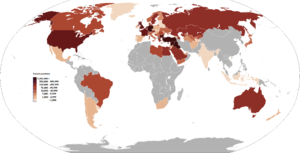
Africa Egypt · Libya · South AfricaAmericas Asia Europe Austria · Azerbaijan · Belgium · Bosnia and Herzegovina · Bulgaria · Cyprus (Turkish Cypriot diaspora) · Denmark · Finland · France · Germany (Berlin) · Greece (Crete / Dodecanese / Western Thrace) · Hungary · Ireland · Italy · Kosovo · Liechtenstein · Macedonia · Moldova · Montenegro · Netherlands · Norway · Poland · Romania · Russia · Serbia · Spain · Sweden · Switzerland · Turkey · Ukraine · United Kingdom (London)Oceania See also Turkish minorities in the former Ottoman Empire · Turks in Europe · Turks in the Balkans · Turks in the former Soviet Union · Turks in the Middle East · Turkish populationCategories:- Cypriot people
- Turkish Cypriot people
- Cypriot society
- Turkish diaspora
- Oghuz Turks
Wikimedia Foundation. 2010.

